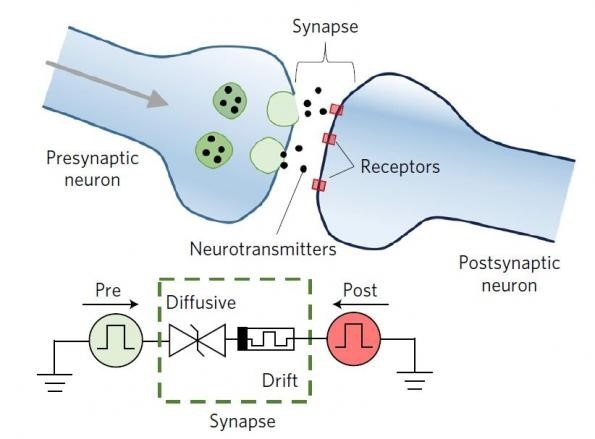It's getting closer, folks, the ability of computers to think like the human brain. Or so it seems, anyway. (By the way, this blog was conceived, written and posted by a human.)
Neuromorphic (brain-inspired) computing mimics human cognition using a variety of techniques. At its most basic, the high-end technology involves microprocessors configured more like human brains than like traditional computer chips.
At the University of Massachusetts Amherst, an international team of researchers are collaborating to develop a new type of nanodevice—called a memristive device—for computer microprocessors that can mimic the functioning of a biological synapse (the place where a signal passes from one nerve cell to another in the body.)
Memristors, which are, basically, a fourth class of electrical circuit that joins the resistor, the capacitor, and the inductor, exhibit their unique properties primarily at the nanoscale,
according to memristor.org. Memristors, a concatenation of “memory resistors," are passive circuit elements that maintain a relationship between the time integrals of current and voltage across a two terminal element.
Thus, a memristors resistance varies according to a device's memristance function, allowing, via tiny read charges, access to a “history” of applied voltage.
Memristors offer a critical benefit in that they can store and process information and offer several key performance characteristics that exceed conventional integrated circuit technology.
MEMRISTORS SURPASS CONVENTIONAL APPROACHES
“Memristors have become a leading candidate to enable neuromorphic computing by reproducing the functions in biological synapses and neurons in a neural network system, while providing advantages in energy and size,” says J. Joshua Yang, a professor in the electrical and computer engineering (EECE) department in the UMass Amherst College of Engineering.
Qiangfei Xia, one of Yang's fellow researchers and also a professor in the UMass Amherst EECE department, adds, “This work opens a new avenue of neuromorphic computing hardware based on memristors.”
The research team says that previous work in this field with memristors hasn't implemented diffusive dynamics without using large standard technology like complementary metal–oxide–semiconductor (CMOS). CMOS is commonly used in microprocessors, microcontrollers, static RAM, and other digital logic circuits.
They believe their bio-inspired solution to the diffusive dynamics is fundamentally different from the standard technology for integrated circuits while sharing great similarities with synapses.
SYNAPTIC FUNCTIONS VERIFIED IN BOTH SHORT- AND LONG-TERM PLASTICITY
The working mechanism of the proposed novel memristor was confirmed with a combination of in-situ transmission electron microscopy and nanoparticle dynamics simulations. Used together with a non-volatile element (memristor), the operating characteristics of the devices were verified experimentally by demonstrating some important synaptic functions, including both short-term and long-term plasticity.
“Specifically, we developed a diffusive-type memristor where diffusion of atoms offers a similar dynamics and the needed time-scales as its bio-counterpart, leading to a more faithful emulation of actual synapses, i.e., a true synaptic emulator," the team says in a
press release.
The researchers believe that their new approach has considerable advantages over the CMOS approach. Compared to the CMOS approach, they disclose, “The two-terminal diffusive memristor will lead to a significant reduction in footprint, complexity, and energy-consumption.”
The research team's work is featured in the September 26, 2016 online issue of
Nature Materials.




